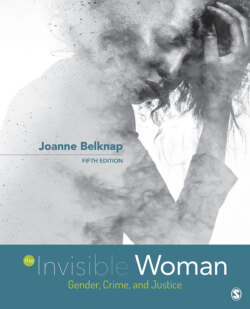Читать книгу The Invisible Woman - Joanne Belknap - Страница 44
3 Theories Part II: Critical, Labeling, Cycle of Violence, Life Course, Pathways, and Masculinity Theories
ОглавлениеEarly scholars focused almost exclusively on men as criminals and as inmates, and it was—and in some cases remains—taken for granted that men and boys were the objects of study in most generalizable criminological research. Yet this empirical pattern alone has rarely been interrogated. Problems of gendered and racialized patterns of criminal offending have been apparent from the start of the discipline but, until the emergence of feminist criminology, were rarely analyzed as conceptual subjects in and of themselves.
—K. J. Cook (2016, p. 336)
The previous chapter was an overview of the classical positivist criminological theories as well as some of the more recent mainstream, and largely sexist and “malestream,” theories. Although social learning theory (SLT), general strain theory (GST), and some of social control theories (SCTs) have made some contributions to a gendered understanding of crime (when including appropriate variables and running models separately by gender), the theories presented in this chapter are more consistent with feminist approaches, even if they have not always been applied so. Except for critical and labeling theories, the theories presented in this chapter are all relatively new, mostly traced back to the mid-1980s and early 1990s. Although research consistent with pathways theory can be seen in research dating back to 1977, this approach was not theorized or labeled as a theory/perspective until the 1992 publication of Daly’s classic article “Women’s Pathways to Felony Court: Feminist Theories of Lawbreaking and Problems of Representation.”
It is vital to notice the overall omitting or avoidance of trauma and abuse variables historically, and to some extent, currently, in criminology theories and theory testing. This might be due to both theorists’ and policy-makers’ hesitancy “to portray male adult offenders as victims during any stage of the life course” (Topitzes, Mersky, & Reynolds, 2011, p. 503), despite Widom’s work dating back to the 1980s documenting the impact of child abuse and neglect on both (traditionally defined) genders’ subsequent offending. This chapter starts with critical theories, followed by labeling, cycle of violence, life course, and pathways theories. Masculinity theory is the final theory presented.
